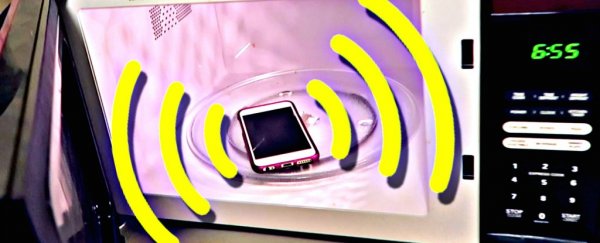Many of us own a microwave - you know, that high-tech box that blasts food with microwave radiation in order to heat it up. But have you ever wondered just how well they insulate electromagnetic radiation? This episode of Physics Girl demonstrates one really simple way to find out.
Before we get started, it's important you know that microwave radiation is non-ionising, which means it can't alter or affect your DNA the way that harmful UV radiation can.
The only way it can hurt you is if you somehow stick yourself in the microwave and heat your tissue up to an unnatural temperature. But let's just say you've got a better chance of burning your mouth on the molten centre of a microwave burrito than being harmed by microwave radiation.
So when we talk about a leaking microwave here, it's to explain the cool way that electromagnetic waves travel - and can be blocked. It's not something you need to be worried about.
Now that we've got that out of the way, let's get to the experiment. All you need to do is put your mobile phone inside your microwave (not switched on) and then call it to figure out how secure your microwave really is.
As Diana explains in the video above, a microwave oven works like a Faraday cage, which is essentially a metal box that 'filters out' electromagnetic waves.
So when electromagnetic radiation hits the outside of a Faraday cage, or the metal grate in the microwave door, it causes electrons in the metal to move and create an electromagnetic field that exactly opposes and cancels out the radiation. Sort of like how noise-cancelling headphones block out noise by playing opposite wavelengths of sound.
With that in mind, you'd expect that microwaves wouldn't let any electromagnetic signals in, and wouldn't let radiation out - unless they had a leak somewhere.
But as Diana shows after trying a few different friends' microwaves, that's not the case.
So what's going on? To figure that out, she gets hold of a device that measures radio wave frequencies, and shows that it's not as simple as it might seem - the signals that your phone receives actually have longer wavelengths than microwaves, so just because one is getting in, doesn't mean the other is getting out.
A signal that's a lot closer in size? Wi-fi.
We don't want to give it all away, but you should definitely watch the video above and try it for yourself at home. If nothing else, it might explain why your internet cuts out every time you're heating up leftovers.
Oh, and one more disclaimer for the road - when you've got your phone in your microwave, do not turn the microwave on. Repeat: do not turn the microwave on.
Unless you want something like this to happen:
Happy physics-ing!
